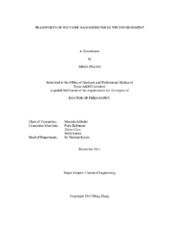| dc.description.abstract | With increasing production and commercial use of polymer nanomedicine and a lack of regulation to govern their disposal, polymer nanomedicine may enter into soils and ultimately into ground water system. In this dissertation, adsorption of polymeric nanoparticulate drug delivery system (PNDDS) in the environmental surface as well as uptake of nanomedicine into plants was investigated. Cellulose surface and silica surface were chosen as environmental surfaces and ryegrass was chosen as a plant.
The adsorption of PNDDS onto cellulose and silica surface was studied by quartz crystal microbalance with dissipation (QCM) and atomic force microscopy (AFM). Uptake of PNDDS into ryegrass was investigated by spectrofluorometry (SFM), confocal microscopy, scanning electron microscopy (SEM) and cross sectional transmission electron microscopy (TEM).
It is found that PNDDS can partially irreversibly adsorb on cellulose and silica surface. After adsorption, PNDDS may deform, disintegrate, or keep the same size depended on properties of PNDDS and PNDDS/surface interaction. Uptake of PNDDS into ryegrass was observed and PNDDS was found both in root cell and intercellular space. PNDDS could transport up to stem of ryegrass but not leaf. Adsorption onto root surface is the rate-determined step of the uptake process.
This dissertation represents an important step in understanding environmental impact of polymer nanomedicine. This is very important considering that PNDDS on and in the plants may later be consumed by animals and bacteria and accumulate in their bodies, and can adversely influence environmental health. Also silica/cellulose surface and plants may also be used to treat waste water with PNDDS. Transport behavior and kinetics of PNDDS onto environmental surface studied in this dissertation also could guide to study transport behavior of the same type or other types of polymer nanomedicine in similar or other environmental systems. | en |


